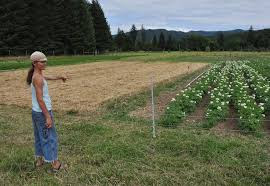Crop Rotations and Cover Crops

Crop Rotations and Cover Crops Levels of soil organic matter may fluctuate during the different stages of a crop rotation. SOM may decrease, then increase, then decrease, and so forth. While annual row crops under conventional moldboard-plow culti-vation usually result in decreased soil organic matter, perennial legumes, grasses, and legume-grass forage crops tend to increase soil organic matter. The high amount of root production by hay and pasture crops, plus the lack of soil disturbance, causes organic mat-ter to accumulate in the soil. This effect is seen in the comparison of organic matter increases when growing alfalfa compared to corn silage (figure 3.3). In addi-tion, different types of crops result in different quanti-ties of residues being returned to the soil. When corn grain is harvested, more residues are left in the field than after soybeans, wheat, potatoes, or lettuce har-vests. Harvesting the same crop in different ways leaves different amounts of residues. When corn grain is har-vested, more residues remain in the field than when the entire plant is harvested for silage or stover is used for purposes like bioenergy (figure 3.4). Soil erosion is greatly reduced and topsoil rich in organic matter is conserved when rotation crops, such as grass or legume hay, are grown year-round. The permanent soil cover and extensive root systems of sod crops account for much of the reduction in erosion Having sod crops as part of a rotation reduces loss of topsoil, decreases decomposition of residues, and builds up organic matter by the extensive residue addition of plant roots. Use of Synthetic Nitrogen Fertilizer Fertilizing very nutrient-deficient soils usually results in greater crop yields. A fringe benefit of this is a greater amount of crop residue—roots, stems, and leaves— resulting from larger and healthier plants. However, nitrogen fertilizer has commonly been applied at much higher rates than needed by plants, frequently by as much as 50%. Evidence is accumulating that having extra mineral nitrogen in soils actually helps organisms better decompose crop residues—resulting in decreased levels of soil organic matter. (See chapter 19 for a detailed discussion of nitrogen management.) Use of Organic Amendments An old practice that helps maintain or increase soil organic matter is to apply manures or other organic residues generated off the field. A study in Vermont dur-ing the 1960s and 1970s found that between 20 and 30 tons (wet weight, including straw or sawdust bedding) of dairy manure per acre were needed to maintain soil organic matter levels when silage corn was grown each year. This is equivalent to one or one and a half times the amount produced by a large Holstein cow over the whole year. Varying types of manure—like bedded, liquid stored, digested, etc.—can produce very different effects on soil organic matter and nutrient availability. Manures differ in their initial composition and also are affected by how they are stored and handled in the field—for example, surface applied or incorporated. ORGANIC MATTER DISTRIBUTION IN SOIL With Depth in the Soil In general, more organic matter is present near the sur-face than deeper in the soil (see figure 3.5). This is one of the main reasons that topsoils are more productive than subsoils exposed by erosion or mechanical removal of surface soil layers. Some of the plant residues that eventually become part of the soil organic matter are from the aboveground portion of plants. In most cases, plant roots are believed to contribute more to a soil’s organic matter than the crop’s shoots and leaves. But when the plant dies or sheds leaves or branches, depos-iting residues on the surface, earthworms and insects help incorporate the residues on the surface deeper into the soil. The highest concentrations of organic matter, however, remain within 1 foot of the surface. Litter layers that commonly develop on the surface of forest soils may have very high organic matter con-tents (figure 3.5a). Plowing forest soils after removal of the trees incorporates the litter layers into the mineral soil. The incorporated litter decomposes rapidly, and an agricultural soil derived from a sandy forest soil in the North or a silt loam in the South would likely have a dis-tribution of organic matter similar to that indicated in figure 3.5b. Soils of the tall-grass prairies have a deeper distribution of organic matter (see figure 3.5c). After cultivation of these soils for 50 years, far less organic matter remains (figure 3.5d). Crop Rotations and Cover Crops